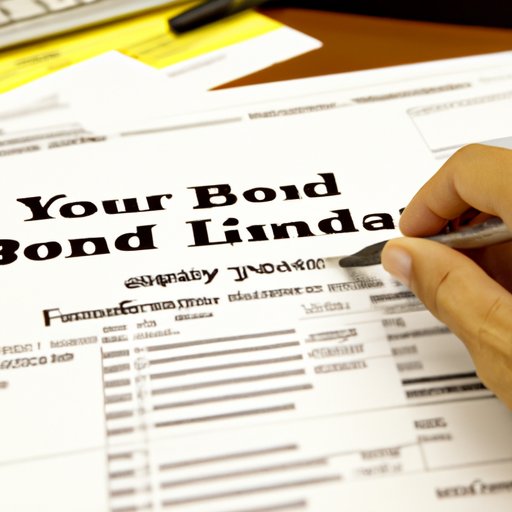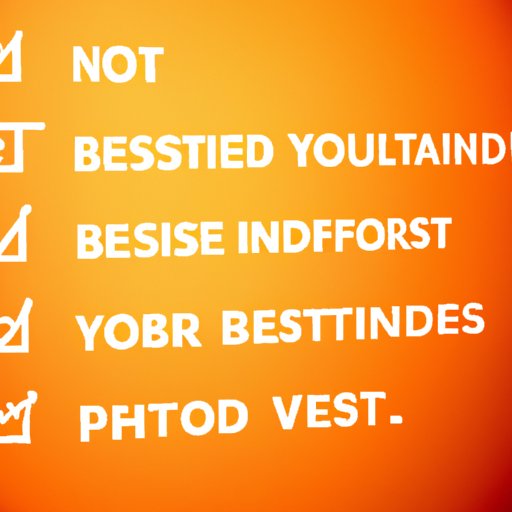Introduction
Bonds are one of the most popular options when it comes to investing, as they provide steady income and are generally less volatile than stocks. When considering which bond to invest in, it’s important to understand the different types of bonds available, their benefits, and how to analyze your financial goals to determine the right bond for you. In this article, we’ll explore what bond should you invest in and provide tips for maximizing your returns on bond investments.

Analyzing Your Financial Goals to Determine the Right Bond for You
The first step in deciding which bond to invest in is assessing your short-term and long-term financial goals. Are you looking for an investment that will generate steady income over the long term, or are you looking to capitalize on short-term opportunities in the bond market? Understanding your goals will help you narrow down the type of bond that is best suited to meet your needs.
In addition to understanding your goals, it’s important to consider your risk tolerance and investment horizon. While some bonds may offer higher yields, they may also come with higher levels of risk. It’s important to assess your risk tolerance and decide if you’re willing to accept higher levels of volatility in exchange for potentially higher returns.
Comparing Interest Rates on Different Bonds
Once you have identified your goals and assessed your risk tolerance, the next step is to compare interest rates on different types of bonds. Generally speaking, the higher the interest rate, the more attractive the bond is to investors. However, it’s important to understand that interest rates vary among different types of bonds, so it’s important to compare them before making an investment decision.
When comparing interest rates, it’s also important to understand bond yields. Yields refer to the return that a bondholder receives in relation to the price paid for the bond. Generally speaking, the higher the yield, the more attractive the bond is to investors. It’s important to compare both bond prices and yields when selecting a bond to invest in.
Examining Risk Factors Associated with Investing in Bonds
Before investing in any bond, it’s important to understand the risk factors associated with investing in bonds. There are three main risk factors to consider: credit risk, market risk, and inflation risk. Credit risk refers to the risk that the issuer of the bond will default on their payments, while market risk refers to the risk that the bond’s value will decrease due to changes in the overall bond market. Finally, inflation risk refers to the risk that inflation will erode the purchasing power of the bond’s interest payments.

Strategies for Choosing the Best Bond Investment
Once you have identified your financial goals, compared interest rates, and evaluated the risk factors associated with investing in bonds, you can begin to develop a strategy for choosing the best bond investment. Here are some tips to keep in mind when selecting a bond:
- Diversifying your portfolio by investing in a variety of bonds with different maturities, yields, and credit ratings.
- Investing in high-quality bonds with strong credit ratings.
- Evaluating the tax implications of investing in different types of bonds.

Tips for Maximizing Your Returns on Bond Investments
Once you have chosen a bond to invest in, there are several steps you can take to maximize your returns. First, look for low-cost bonds, as these tend to offer higher yields. Second, rebalance your portfolio regularly to ensure that your investments remain aligned with your goals. Finally, hold your bonds until maturity to maximize your returns.
Conclusion
Investing in bonds can be a great way to diversify your portfolio and grow your wealth. When choosing a bond to invest in, it’s important to understand the different types of bonds available, assess your financial goals, compare interest rates, evaluate risk factors, and develop a strategy for selecting the best bond for your needs. By following these tips and using the strategies outlined in this article, you can maximize your returns on bond investments.
(Note: Is this article not meeting your expectations? Do you have knowledge or insights to share? Unlock new opportunities and expand your reach by joining our authors team. Click Registration to join us and share your expertise with our readers.)
